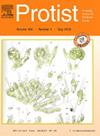转录组学分析揭示了未栽培棘虫(Radiolaria)生殖阶段的性暗示
IF 2.1
3区 生物学
Q4 MICROBIOLOGY
引用次数: 0
摘要
繁殖能力是生物体永续的关键过程。在原生生物生殖策略的进化过程中,性重组的分子机制估计是从最后的真核生物共同祖先(LECA)那里遗传下来的。考虑到许多未开垦的生命阶段的神秘角色,解开自由生活的原生生物的性周期仍然具有挑战性。对于浮游生物群棘虫(放射虫),一种假设的性循环自19世纪晚期就被提出,包括一个类似配子的阶段,被称为群集。为了研究棘虫生殖阶段的性别性质,我们比较了棘虫不同生命阶段的转录组。我们的研究结果显示了不同的生殖和营养阶段的功能谱,同时揭示了配子融合基因HAP2/GCS1和KAR5-GEX1-BMB在蜂群中的表达。不同表达的生命阶段特异性基因的注释也强调了在蜂群前和蜂群期之间可能存在的减数分裂相关功能,同时表明可能存在合子期。这种原始的生命阶段特异性遗传数据与支持棘虫性循环的形态学证据是一致的,蜂群充当配子。此外,它为在单细胞尺度上更深入地了解放射虫细胞生物学和生态学铺平了道路。本文章由计算机程序翻译,如有差异,请以英文原文为准。
Transcriptomic analyses reveal sexual cues in reproductive life stages of uncultivated Acantharia (Radiolaria)
The ability to reproduce is a key process for the perpetuation of organisms. Along the evolution of protist reproductive strategies, the molecular machinery of sexual recombination is estimated to have been inherited from the last eukaryotic common ancestor (LECA). Unraveling the sexual cycles of free-living protists remains challenging, given the enigmatic roles of many uncultivated life stages. For the planktonic group of Acantharia (Radiolaria), a hypothetical sexual cycle has been proposed since the late 19th century, including a gamete-like stage, referred to as swarmers. In order to investigate the sexual nature of acantharian reproductive stages, we compared transcriptomes of various acantharian life stages. Our results show distinct functional profiles for reproductive and vegetative stages, while revealing the expression of the gamete fusion genes, HAP2/GCS1 and KAR5-GEX1-BMB in swarmers. Annotation of differentially expressed life stage-specific genes, also highlighted putative meiosis-related functions among pre-swarmer and swarmer stages, while suggesting the existence of a putative zygotic stage. This original life stage-specific genetic data is coherent with morphological evidence supporting the acantharian sexual cycle, with swarmers acting as gametes. Moreover, it paves the way for a deeper understanding of radiolarian cell biology and ecology at a single-cell scale.
求助全文
通过发布文献求助,成功后即可免费获取论文全文。
去求助
来源期刊

Protist
生物-微生物学
CiteScore
3.60
自引率
4.00%
发文量
43
审稿时长
18.7 weeks
期刊介绍:
Protist is the international forum for reporting substantial and novel findings in any area of research on protists. The criteria for acceptance of manuscripts are scientific excellence, significance, and interest for a broad readership. Suitable subject areas include: molecular, cell and developmental biology, biochemistry, systematics and phylogeny, and ecology of protists. Both autotrophic and heterotrophic protists as well as parasites are covered. The journal publishes original papers, short historical perspectives and includes a news and views section.
 求助内容:
求助内容: 应助结果提醒方式:
应助结果提醒方式:


